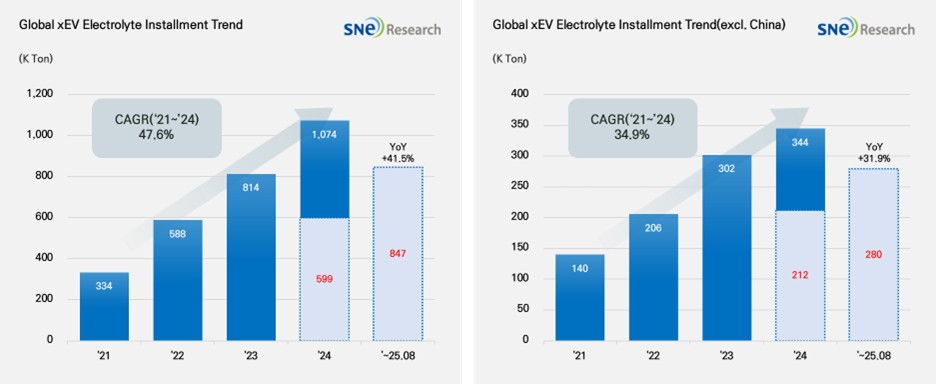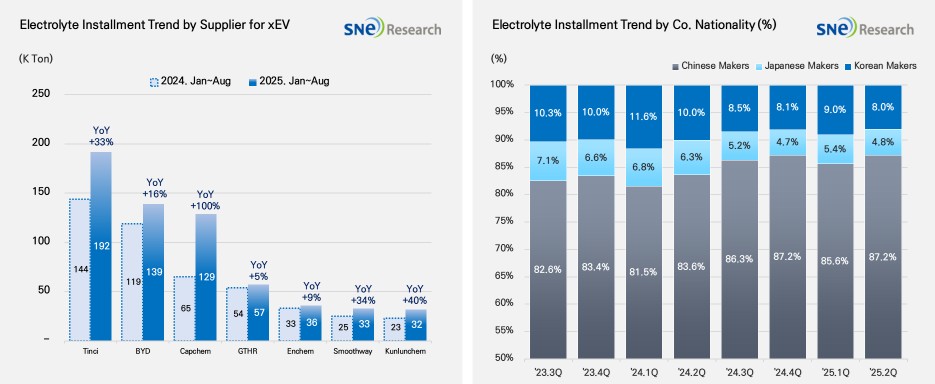From Jan to Aug 2025, Global[1] Electronic Vehicle Battery Electrolyte Installment[2] Reached 847K ton, a 41.5% YoY Growth
- In 2025, the
electrolyte market continued to post a double-digit growth, while the non-China
market showed a stable expansion in demand

(Source: 2025 Sep Global EV & Battery Monthly Tracker (Incl. LiB 4 Major Materials), SNE Research)
From Jan to Aug 2025, the total installment of electrolyte used in electric vehicles (EV, PHEV, HEV) registered around the world was approx. 847K ton, posting a 41.5% YoY growth. Particularly in the global market outside China, the total usage of electrolyte for electric vehicles recorded 280K ton and 31.9% YoY growth, continuously exhibiting a stable expansion in demand.
Electrolyte is one of the key materials and facilitates the transfer of lithium ions inside batteries, directly affecting the battery charging speed, safety, and battery life. With the electric vehicle market expanding and demand for high-performance batteries increasing, the electrolyte market is expected to continue steady growth in the mid to long run.
From Jan to Aug 2025, the global electrolyte market showed remarkable growth among major electrolyte suppliers. Tinci took the top position in the market, posting a 33.4% YoY growth by supplying 192K tons of electrolyte. BYD followed Tinci in the ranking with 139K ton, a 16.2% increase. Capchem boasted a 100.0% growth with 129K tons, while GTHR had 57K tons of its electrolyte installed in batteries for electric vehicles. Smoothway posted a 33.6% growth with 33K ton. Korean electrolyte suppliers such as Enchem (36K ton, +9.3%) and Soulbrain (23K ton, +19.1%) also maintained steady growth.

(Source: 2025 Sep Global EV & Battery Monthly Tracker (Incl. LiB 4 Major Materials), SNE Research)
In terms of market shares of companies by nationality, the Chinese electrolyte suppliers are still leading the market. As of Q2 2025, the market shares taken by the Chinese electrolyte companies were 87.3%, while the Korean and Japanese companies took up 7.9% and 4.8%, respectively. The market shares held by the Korean and Japanese electrolyte makers were slightly lower than the same period of last year. While the Chinese companies are solidifying their market dominance, it becomes more important for the non-China companies to secure their own competitive edge.
Recently, while facing the increasing demand for high-performance battery and pressures from geopolitical risks, the electrolyte market has entered a transition phase where both technological advancement and supply chain restructuring are required. Particularly, with the US government strengthening the tariffs policies on battery materials and the EU making the investigation supply chain mandatory, electrolyte manufacturers have been trying to establish response measures focusing on stability of raw material supply and production facilities based in North America.
Along with this trend, in order to respond to demand for high-power and high-energy-density battery with safety at high temperature and voltage stability, more electrolyte makers are increasingly working on development of premium electrolytes such as high-fluoride solvent and high-heat-resistance additives. Major electrolytes companies have been agile in transitioning their product portfolios from general-purpose products to high-value-added ones.
Later, the electrolyte market is highly likely to restructure based on various competition factors such as capabilities to internalize material technologies, stability in local supply chain, and ESG-based procurement system. It is expected that those who took preemptive measures to build capabilities to provide customized solutions and strategic cooperation relations would take a leading position in the market.
[2] Based on batteries installed to electric vehicles registered during the relevant period.

